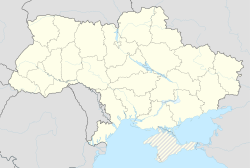Sumy
| Sumy Суми Сумы |
|||
|---|---|---|---|

Ukrainian Academy of Banking in Sumy
|
|||
|
|||
| Location within Ukraine | |||
| Coordinates: 50°55′N 34°45′E / 50.917°N 34.750°ECoordinates: 50°55′N 34°45′E / 50.917°N 34.750°E | |||
| Country |
|
||
| Oblast | Sumy Oblast | ||
| Raion | Sumy | ||
| Founded | 1655 | ||
| Government | |||
| • Mayor | Oleksandr Lysenko (Batkivshchyna) | ||
| Area | |||
| • Total | 145 km2 (56 sq mi) | ||
| Population (2015) | |||
| • Total | 270,870 | ||
| • Density | 1,988/km2 (5,150/sq mi) | ||
| Time zone | CET (UTC+2) | ||
| • Summer (DST) | CEST (UTC+3) | ||
| Postal code | 40000-40035 | ||
| Area code(s) | +380 542 | ||
| Website | http://www.meria.sumy.ua | ||
Sumy (Ukrainian: Суми [ˈsumɪ], Russian: Сумы) is a city in north-eastern Ukraine, and the capital of the Sumy Oblast (region). In 2015, the city's population was 269,000. Private planes are served by Sumy Airport.
Sumy was founded in 1652 at the bank of the Psel River (a left tributary of the Dnieper) as a Cossack fortress. It was intended to protect Sloboda Ukraine from the Crimean Tatar attacks. After their attacks ceased and the territory was incorporated into the Russian Empire, Sumy evolved into an important economical centre, mainly focusing on sugar industry.
During the Revolution of 1905, Sumy was one of several areas which became famous throughout Russia for in effect having established an independent peasant republic; the Sumy Republic was established by a peasant union.
During the German occupation of Ukraine during World War II (1941 – 1944), Sumy sustained heavy damage. Sumy was occupied from October 10, 1941 to September 2, 1943. After the war, the destroyed parts of the city were built anew. Sumy has been a twin town of Celle, Germany since January 17, 1990.
The city used to be divided into two urban raions (districts), Zarichny and Kovpakovsky, and 13 micro-raions. The first were dissolved in 2006.
...
Wikipedia



